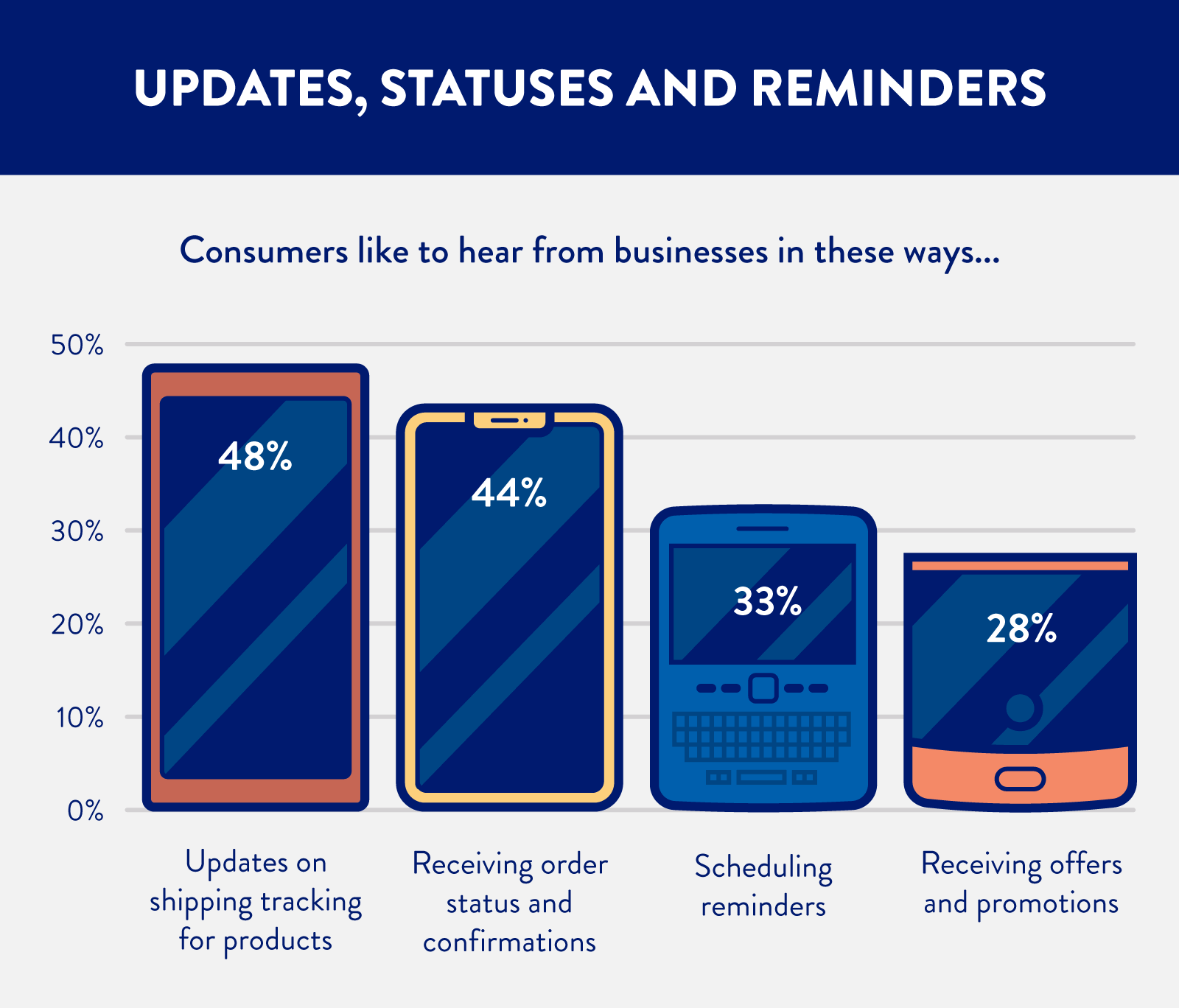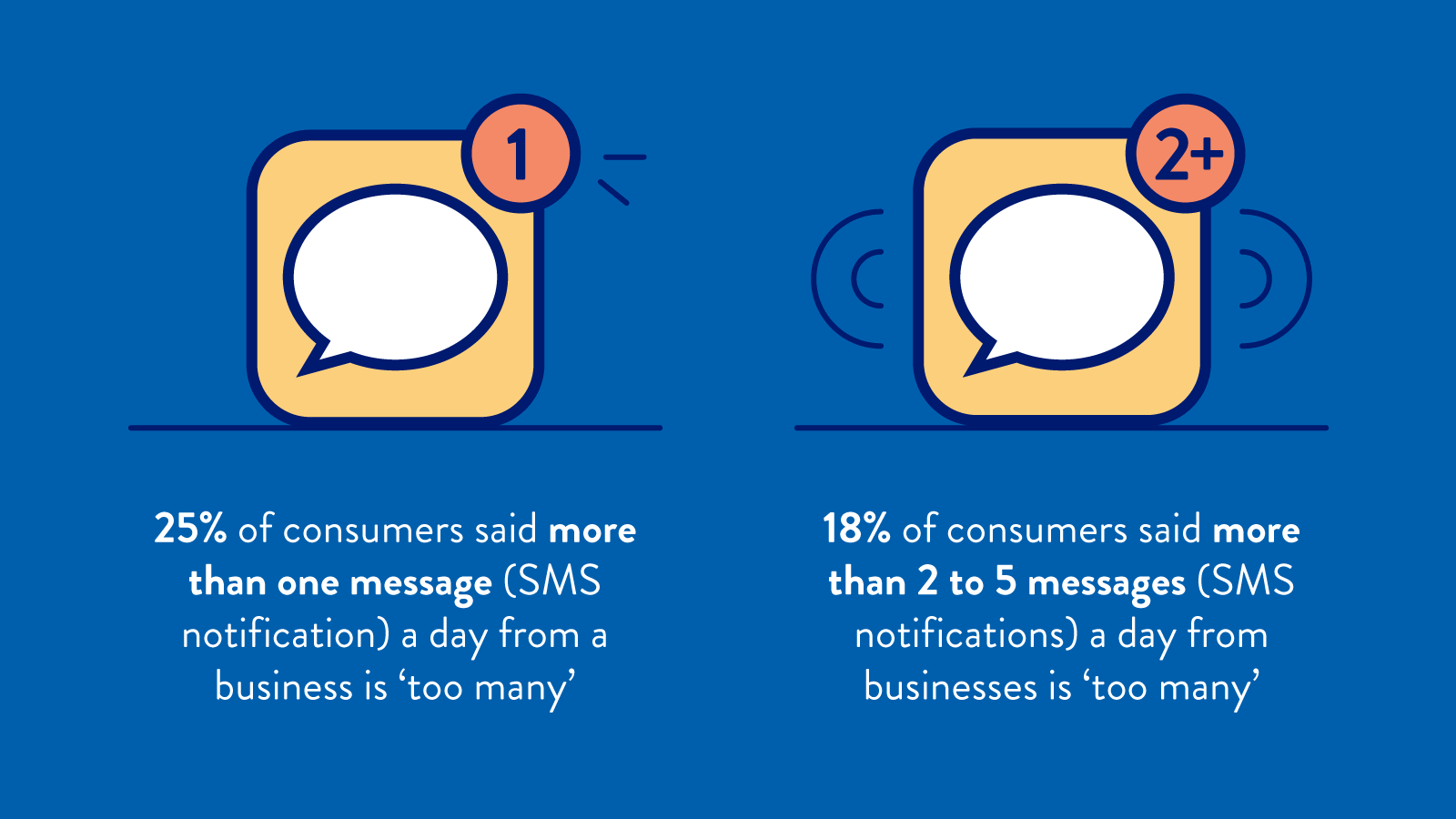Want to hear something shocking? SMS turns 29 this year. That’s right: the first SMS, which said “Merry Christmas,” was sent by Neil Papworth to his Vodafone colleague, Richard Jarvis, in December 1992.
What started as a friendly, festive message, sparked a texting phenomenon. Almost 30 years later, consumers and businesses rely on SMS, or short message service, as an essential communication tool.
On average, the open rate for text message marketing campaigns is 98% compared to 20% for email marketing campaigns*. This is good news for businesses investing in SMS marketing. But it’s important to note that an open rate doesn’t necessarily mean engagement, particularly if your SMS marketing efforts don’t align with what your customers want.
To help you increase both open rates and engagement levels, we surveyed 1,000 respondents to find out what consumers really think about SMS notifications from businesses. In this post, we share the inside scoop from consumers on which industries send the “’best” marketing messages, the ways that businesses annoy customers with notifications, and the ideal frequency.
Jump down to our infographic for the essential takeaways about how consumers really feel.
Which Industries Send the Best Marketing Text Messages?

When we asked consumers which industries sent the “best” marketing text messages, the findings revealed three industries that people rank highly when it comes to SMS marketing best practices. More than half (56%) of respondents ranked food-related industries highly, with restaurants coming in on top, followed closely by food delivery and groceries.
The enthusiasm for these industries extends across consumer behavior as well: 47% of respondents who selected the food delivery and groceries industry said they order takeaway several times a month.
Here’s more food for thought: when asked about spending priorities, 26% of respondents who selected the food delivery and groceries industry said eating out was their number one priority. Compare that with 39% who said the restaurant industry was best at sending marketing messages.
Key takeaway: Whether your business is large or small, take note of the types of SMS messages that work well in your industry and other industries. Ensure that every message sent has a purpose and a tangible benefit to the recipient. It’s likely that the food delivery and groceries industry ranks highly for these notifications because they directly tie to order or delivery updates. These notifications appear less intrusive and salesy which makes sense here.
You might like to read: What is an SMS short code, & How Does it Work?
Top Four Ways Businesses Annoy Consumers with SMS Notifications

It turns out that SMS notifications from businesses can put consumers off and there are four things in particular that stand out. Here’s where businesses can go wrong:
- Sending notifications to consumers who didn’t sign up for them
- Not providing an opt-out option in the notification
- Sending too many notifications
- Sending notifications that are too “spammy”
If you mostly serve an older audience, be advised that not signing up for an SMS notification is their number one gripe. 29% of respondents aged 65+ said this annoyed them the most, followed closely by 26% of people who are annoyed when there is no opt-out option. On the other hand, spammy texts are the number one annoyance for 35% of Gen Z respondents (aged 18 to 24).
Key takeaway: You absolutely must have permission to send users text messages. Double-check your database to ensure that your audience has opted-in for your business’s SMS notifications and always provide a clear opt-out option. When considering text length, don’t feel obligated to use all 160 characters or to send multiple messages to get your point across.
Updates, Status & Reminders: 3 Types of SMS Notifications Consumers Like

Where is the text confirmation for my purchase? When is my package arriving? These are common questions that consumers ask regularly, so it’s no surprise that these are the types of SMS notifications that they like to receive from businesses. Half of respondents (48%) said updates on shipment tracking for products are how they prefer that businesses stay in touch, and 44% like to receive order confirmation and status updates.
In case your business is looking to launch referral or customer loyalty programs, it’s worth considering another channel: only 12% of consumers said they like to receive sign-ups for loyalty programs via SMS notifications. Only 4% like notifications about referral programs for friends and family. For example, consider push notifications.
Key takeaway: When it comes to SMS notifications, the findings reveal that the majority of consumers are just looking for logistical messages, like appointment reminders, shipping updates, and order confirmations. However, this doesn’t mean that you shouldn’t use SMS notifications for other marketing campaigns.
28% of Consumers Want SMS Notifications Only During the Week

What do SMS notifications and baking have in common? Timing is one of the most important ingredients for success. When asked when is the best time to receive a marketing SMS notification, 28% of consumers said anytime during the week (Monday to Friday). Looking specifically at time brackets, 20% said between 10 a.m. and 1 p.m. on weekdays works best.
Weekends aren’t off-limits but it’s certainly not ideal for the majority of consumers. Only 8% said they are happy to receive marketing SMS notifications anytime during the weekend. This is slightly higher for Gen Z — 10% said anytime during the weekend is good for notifications.
Key takeaway: While these timings depend on industries, weekdays are ideal for most age groups and consumers. We recommend that you try sending marketing messages between 10 a.m. and 1 p.m., Monday to Friday, and monitor open rate and engagement. Adjust accordingly and perhaps try different message formats like push or email during the weekend.
The Biggest Mistakes That Businesses Make When it Comes to SMS Notifications

We’ve touched on what annoys consumers when it comes to SMS notifications, but what are the three biggest mistakes that businesses make?
- 37% said sending unsolicited messages
- 30% sending too many messages
- 14% said sending long, spammy messages
Although sending unsolicited messages is the number one mistake, the consensus is that sending too many messages is just as bad — 30% of people from each age group said this is the biggest mistake that businesses can make.
Key takeaway: Test, test, and test some more. As mentioned above, ensure that consumers have opted-in for marketing messages, and that these messages contain assets and content that deliver real value for your audience.
Get the Message: 25% of Consumers Say 1+ SMS Notification a Day is Too Many

Not only do businesses annoy consumers with too many messages, but according to our survey, even two messages a day falls under the ”too many” umbrella, particularly for 25% of consumers. For 18% of respondents, between two and five daily messages from businesses is too much.
For others, receiving multiple messages a week is viewed as overkill: 21% said more than one a week is excessive compared to 19% who said more than two to five messages a week is too much. Younger consumers (aged 18 to 24) indicated that multiple messages a day or even a week is too much compared to older consumers (65+) who find more than one message a day excessive.
Key takeaway: Less is more. If your marketing strategy includes sending multiple messages a day or a week, take a step back and examine whether this is actually the best course of action. According to our findings, consumers want to hear from you — but businesses should consider quality over quantity.
Whether your marketing strategy includes SMS notifications or push notifications or both, we always recommend aligning your strategy with what your consumers want. We hope these findings bring you one step closer to an effective and engaging SMS marketing strategy. Where possible, why not run your own survey or study to find out how your consumers really feel about your SMS notifications? Until then, check out our infographic that highlights the steps to help consumers get the message.
Methodology
The survey was conducted on YouGov Direct. 1,000 US adults 18+ were surveyed on March 26, 2021 between 4:00 pm and 7:15 pm Eastern time. Data is weighted on age, gender, education level, political affiliation, and ethnicity to be nationally representative of adults 18+ in the United States. The margin of error is approximately 3.3% for the overall sample. 

See how today’s top brands use CleverTap to drive long-term growth and retention
Subharun Mukherjee 
Heads Cross-Functional Marketing.Expert in SaaS Product Marketing, CX & GTM strategies.
Free Customer Engagement Guides
Join our newsletter for actionable tips and proven strategies to grow your business and engage your customers.















































